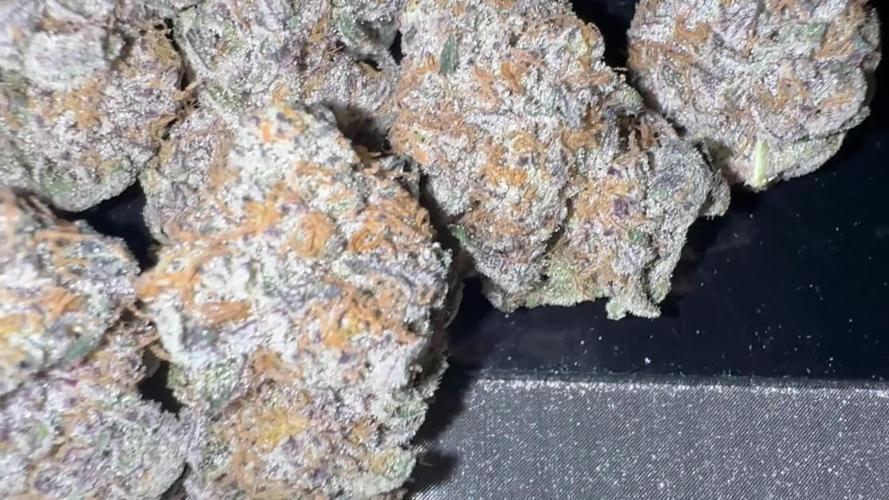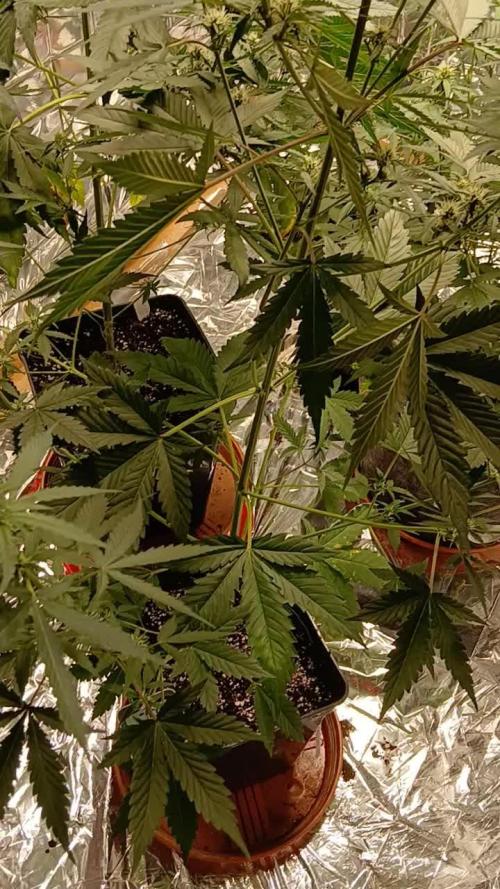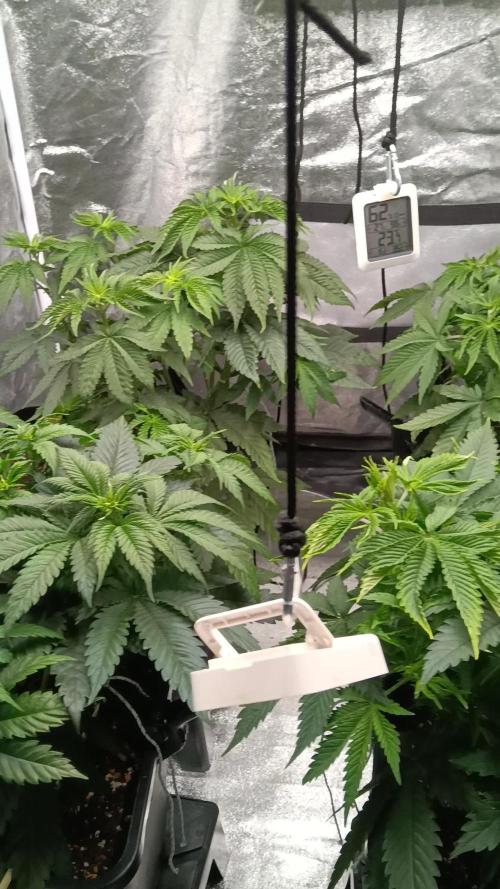The Grow Awards 2026 🏆 































Likes
Comments
Share


@Kitties_and_Colas
Follow
~_~_~_~_~_~_~_~_~_~_~_~_~_~_~_~_~_~_~_~_~_~_~_~_~_~_~_~_~_~_~_~_~_~_~_~_~_~_~_~_~_~_~_~_~_~_~_~_~_~_~_~_~_~_~_~_~_~_~_~_~_~_~_~_~_~_~_~_~_~_~_~_~_~_~_~_~_~_~_~_~_~_~_
3/26/22
😻 First day of week 6!! These girls are starting to get REALLY frosty!! We dropped the MarsHydro 2inches this week, we're approximately 22" from the lowest and 18" from the highest part of the canopy..we're monitoring closely, we've burned plants close to this distance before.. the extra shot of N straightened their color out fast, they look great today..we removed all large fans just from cola tops so they receive as much direct light as possible for the next few weeks..its been an effortless run so far!! We'll upload again midweek. thanks for dropping by and happy harvests everyone!!
⚡Mars Hydro/SP-3000⚡ Specifications ⚙️:
Diodes: Samsung LM301B / Osram 660nm (960 total!)
Driver: Meanwell 300watt 🔌 (300W±5% @AC120V-277V)
PPF: 824umol/S ☢️
PPE: 2.8 µmol/j 〰️〰️
Lifespan: 50k+ hrs ⌛
Weight: 10.1 lbs (4.6kg)
Veg Coverage: 3 x 5 ft 🌱
Flowering Coverage: 2 x 4 ft 🌼
-The SP-3000 uses an aluminum heatsink (no fan) and the driver can be placed outside the tent 🌡️⬇️
-IP65 waterproof ratings, tolerant to high humidity grow environments 💦 ..
-Up to 15 can be daisy-chained together and all controlled from a single light! 💡~💡~💡~💡
~_~_~_~_~_~_~_~_~_~_~_~_~_~_~_~_~_~_~_~
Song: "I got a girl"
Artist: Philip Morris
~_~_~_~_~_~_~_~_~_~_~_~_~_~_~_~_~_~_~_~_~_~_~_~_~_~_~_~_~_~_~_~_~_~_~_~_~_~_~_~_~_~_~_~_~_~_~_~_~_~_~_~_~_~_~_~_~_~_~_~_~_~_~_~_~_~_~_~_~_~_~_~_~_~_~_~_~_~_~_~_~_~_~_
Likes
5
Share


@MrGrOH1008
Follow
Chopped on Day 62. These 2 are citrus, pinesol, gassy dipped lemon wedges smelling.
Likes
38
Share


@DomanAtrik
Follow
I've caught various carnivorous critters and released them in my garden. They seem happy here. Just began using overdrive. Cant wait for next weeks pictures.
Likes
3
Share


@kdifiori_
Follow
It's still too hot outside to do anything to lower the temperature, but despite everything, the girls are doing very well.
Likes
5
Share


@SgtDoofy
Follow
Feb 27
Swapped over to an 18/6 light schedule a couple days back. Getting some really good perking-up during sleep.
Not quite ready for LST yet.
Likes
35
Share


@bmvape
Follow
The Northern Light produced almost twice as much as White Widow. As they were in the same basin, I attribute the better performance to three factors. 1. Roots made it to basin faster. The WW's pellet dried out before her roots were in the water as the airstone shifted right under the NL.
2. The second and more powerful light was placed directly over the NL, however, the space is so small that they both should have benfited.
3. I did a better LST job on the NL.
Overall, happy with the harvest. The buds are airy, my fault. The smell is very lemony with a bit of an earthy smell during the cure. Currently, the taste is minty and refreshing, but still a bit heavy. Effects are nice. Noticeable but not overwhelming or tiring. I think potency will come with age,
But both plants tolerated my inexperience and have produced enough fruit to get me by. What else could you ask for out of a first grow?!
Thanks to everyone that helped! Wish I found this community from the start.
Likes
5
Share


@Budzalot
Follow
Day 31. Trimmed 2 times not as bushy as led tent. Think I'm going to flip to flower next feed on wedsday
Likes
75
Share


@DogDoctorOfficial
Follow
Week 6: Nurturing the Monstrous Beauty of Panty Punch Auto
As we embark on Week 6 of our cultivation journey with Panty Punch Auto, it's time to reflect on the remarkable evolution of this botanical marvel, from a tiny seed to the towering giant adorned with lush foliage and bountiful buds. In this report, we delve deep into the intricate fixings, sticks, and bendings that have shaped her growth, alongside an exploration of the revolutionary TrolMaster technology, with a special focus on the unveiling of the Tent-X controller.
From the earliest days of her life, Panty Punch Auto has been a testament to resilience and determination. Through meticulous care and strategic interventions, we've guided her growth, ensuring she thrives in our grow space. Fixings sticks have been instrumental in supporting her weighty branches, while gentle bendings have encouraged optimal light exposure and airflow, resulting in a robust plant with an abundance of branches and buds.
At the heart of our environmental control strategy lies the TrolMaster system, a game-changer in precision cultivation. This week, we're thrilled to introduce the Tent-X controller, a cutting-edge addition to our arsenal of tools. In an unboxing video, we'll unveil the Tent-X controller and explore its myriad features, including its integration with the Lumatek Zeus using the LMA-14 interface.
The Tent-X controller represents a paradigm shift in grow environment management, offering unparalleled control and flexibility. With its advanced capabilities, we can fine-tune every aspect of our grow space, from temperature and humidity to lighting schedules and CO2 levels. The LMA-14 interface acts as a bridge between the Tent-X controller and the Lumatek Zeus, enabling seamless communication and synchronization for optimal plant growth and development.
But the innovation doesn't stop there. The Tent-X controller comes equipped with a 3-in-1 sensor, providing real-time monitoring of temperature, humidity, and light intensity. This invaluable tool allows us to maintain the ideal growing conditions for Panty Punch Auto, ensuring she thrives in her environment.
As we marvel at the extraordinary progress of Panty Punch Auto, it's essential to express our gratitude to those who have made this journey possible. A heartfelt thank you to TrolMaster for providing the revolutionary Tent-X controller, to Aptus Holland for their unwavering support and exceptional nutrients, to Grow Diaries for the platform that connects us with fellow growers, and to the vibrant community for their endless encouragement and inspiration.
In conclusion, Week 6 marks another milestone in the cultivation of Panty Punch Auto, a testament to the power of innovation, dedication, and community. As we continue to nurture her growth, let us anticipate the wonders yet to come and celebrate the beauty of this monstrous plant.
Stay tuned for more updates as we witness the ongoing evolution of Panty Punch Auto and explore the boundless possibilities of modern cultivation techniques. Together, we'll continue to push the boundaries of what's possible and cultivate excellence in every leaf and bud.
#PantyPunchAutoAdventure #RootsAndFruits #TrolMasterControl #GrowDiariesCommunity #CultivationExcellence
Genetics - Panty Punch Auto - https://seedstockers.com/
Plant nutrition - Aptus Holland - https://aptus-holland.com
LED Photons - Lumatek - https://lumatek-lighting.com
Controls - Trol Master - https://www.trolmaster.eu/
Watering - myself
Love and attention - Me, myself and i
As always thank you all for stopping by, for the love and for it all , this journey of mine wold just not be the same without you guys, the love and support is very much appreciated and i fell honored and blessed with you all in my life, With true love comes happiness. Always believe in your self and always do things expecting nothing and with an open heart , be a giver and the universe will give back to you in ways you could not even imagine so
More info, the ocasional give-away and exclusive updates from all my adventures can be found - links in the profile description
Friendly reminder all you see here is pure research and for educational purposes only
Growers Love To you All 💚 💚 💚
Processing
Likes
19
Share


@CannabisAprendiz
Follow
Esta es una genética de un olor muy fuerte y pesado se siente intenso desde la vegetación , es una variedad muy resinosa con unos colores morados hermosos , probando las flores cuando terminó el secado y ahora curando las flores se siente un sabor terroso , al principio no me gusto ya que nunca había probado este , pero después al seguir fumando se siente un sabor final muy agradable.
Esta genética se conservará para futuros cruces y experimentar algo nuevo.
muy conforme con la producción de cada clon
Likes
20
Share


@DeepRootsGrowTrees
Follow
KRITIC AUTO by KANNABIA
Week #7 Overall
Week #4 Flower
This week she's looking and smelling good👍 she has a some nice dense buds on her that have good trichome coverage. Great genetics for a auto flower! Stay Growing!!
Kannabia.com KRITIC AUTO
Processing
Likes
13
Share


@Cheesefarmer420
Follow
This plant has a solid stench of pure ripe lemons. So much aroma and color in every bud, purples, to dark green, to lime green, to solid frost. This one definitely a fun strain to watch grow and tend too for the last few months. She’s definitely a hungry girl, seemed to be the only strain out of the three that accepted and thrived with full feed nutrients. Would definitely recommend this Strain to someone For a nice uplifting day smoke, also seems to do me good for some pain and stress relief.
Likes
2
Share


@amazingautoflowers
Follow
A good week with a lot of growth. I took these pictures today right after feedings. This was the second feeding of this same mix. As of today, they are 18 days old today. Looking quite nice. As you can see in the pictures they are just starting to show. I give a really good look at them in the video. And as you can see they are just beginning to show some white hairs, so I think next week we will be in flower.
So far so good. hopefully, it continues.
Happy grow everyone!
Processing
Likes
21
Share


@PrairieFrostGrow
Follow
********Week 1 Flower - Sept 19 to 25, 2020*******
We switched to flower this week and put in the first SCROG layer.....been busy😃These girls have been pretty happy this week given they have grown quite tall and buds are setting and moved on to stacking already. Great signs so early on😎🤞 I had LST on the girls and then decided to remove the ties since they were topped and under a net so maybe stretch wouldn’t be too bad.......ties went back on at the end of the week😃💪🤪 Pheno 4 has on branch that had HST done and knuckle formed, still growing up so had to keep it tied down as well. Down side to running a 9 week veg, if they want to get big, they will😂😂😂
Pest maintenance this week as we are getting the last days I am able to comfortably spray the girls. Lost Coast Plant Therapy to keep the gnats, aphids and thrips in check😃
Keeping the waterings up and getting a fair bit of runoff from the feedings but that is best for Coco to avoid lockouts and pH issues. There were only three feeding days this week. We switched to bloom nutes for base and added silica for supplementals. Vitamin B and Kelp coming from B52 and sweetener for the microbes from bud candy, Bud Ignitor doing its thing as PK boost. As well as Sensyzime to let the enzymes clean up the root zone because they have been in the pots for a few weeks now.
Little more detail:
Sept 19/20 - Day 1
- Plant Therapy @ 5ml in 1L water. Ph to 5.4.
- Folier spray applied to whole tent half hour before lights on, used 3/4 of mixture
- Feeding mixture was Sensyzime @ 1ml only
- 25ppm and 5.2pH......missed it a bit.
- each girl given 3L
- SCROG put in
Sept 20/20 - Day 2
- Sprayed the last of the IPM mixture on the tent tonight.
- Noticed several small shinny spots on leaves later today.....suspect from Folier spray on leaves.
Sept 21/20 - Day 3
- Nice full strength week 1 mixture applied today
- Rhino Skin, Cal Mag @ 2ml, Sensi Bloom A&B , B52, Bud Ignitor, Bud Candy @ 1ml.
- 625 ppm and 5.7pH
- 3L given to each girl.......not enough runoff.....bump feedings up to 4L going forward.
- silica added today.
Sept 23/20 - Day 5
- CalMag @ 2ml, Rhino, Sensi Bloom A&B, B52, Bud Candy, Bud Ignitor @ 1ml.
- 850ppm and 5.9pH
- 4L given to each girl.
- better run off amount
That wraps up the first week of flower........The net is in and the lights flipped. The girls were ready for flower and now we just need to keep giving them what they want for the next 6 weeks and then coast from there👍 These are some strong and fast growing girls.....keeps a grower on their toes! I expected the heights to be where they are but must admit I was hopeful that was the end of week 2. Issues will come in when trying to ripen the bud around week 8. They are growing so well right now.....keep them happy and in the end everyone is happy👍❤️👍
Such a solid strain @Sweet_Seeds......a great hybrid you should be very proud of!!! 🙏🙏🙏
Likes
24
Share


@AlexJekomust
Follow
This fantastic plant is growing very well, it has stretched a lot in a few days, tomorrow I want to perform LST otherwise I risk that it touches under the led😂😂.
I did the topping because the plant has stretched a lot, I performed a small LST in order to make the branches grow more and let the light reach the bottom, the plant responds very well to the solicitations and immediately absorbs all the nutrients.
Likes
11
Share


@HazeLiebhaber
Follow
Der KISS ist das Licht wohl etwas zu stark. Die obersten Blätter waren leicht nach oben gerollt und mir zu hell. Auch bei Lemon Orange konnte ich das beobachten, sobald der Abstand zur Lampe weniger als 40cm war. Ansonsten sehen die Ladies gut aus. Sonntag geht es dann wahrscheinlich in die Blüte.
Likes
7
Share


@XoticGROW666
Follow
🍨🍧🌈🍭🍬
Pheno B is more candy gelato terps smell & taste🍨🍧🍬
Pheno A is more butter candy bread terps smell & taste 🍞🥐🍬

























